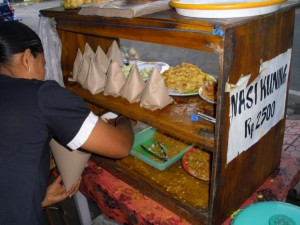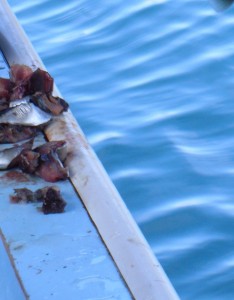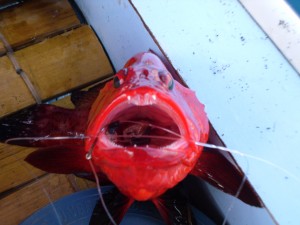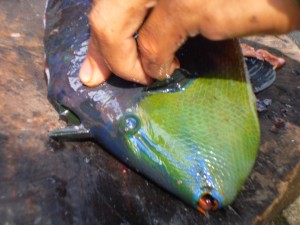In Rugby North Dakota, the geographical center of the North American continent, you are 1,400 road miles (2.300k, over 24 hours driving) from the Pacific or Atlantic Ocean. The small town of my Wyoming childhood is near enough to sometimes compete in sports with North Dakota kids. For my family, going to the ocean to fish was never practical. Especially when there were plenty of streams, rivers, and well-stocked lakes just a fraction of the distance from our front door.
Fast forward twenty years and nine thousand miles to the shores of the Indian Ocean, standing on the sands of Lebih Beach in Bali. Putra, the affluent father of the family compound where I rent a room, had invited me fishing! Ocean fishing!
The short drive to the coast included a roadside stop to pick up twelve packets of Nasi Kuning — rice and a spoonful of five different Balinese dishes packed into a paper cone. The seas were calm as we loaded ourselves into deep, narrow outrigger canoes with small canopies lashed to bamboo frames. The silhouette of the iconic Agung Volcano — the islands largest — stood out against the dawn, awaiting the mid-morning clouds that hide it from view each day.
As we motored out to sea, I watched locals on the shore already at work – “fishing” for rocks in the tepid surf. Using a mesh bag with its opening affixed around a stiff, metal ring, the men and women stand in the breaking waves scooping up black rocks suspended in the turbulence. When the net gets too heavy, they carry the load up above the high-tide line. The bag contents are dumped under a make-shift shelter of driftwood and discarded advertising banners where family members spend their days separating the rocks into graded piles. Putra, my host, reckons the rocks are sold in eight kilo (16 lb.) batches which fetch 50,000 rupiah each — about $5. The rocks are used in decorative murals like the ones on the stairs in the compound leading up to my apartment.
 The rock fishers became harder to see as the ocean swell picked up. We bobbed like a cork, disappearing down into a 10 foot (3 m) trough for a few long seconds before riding the wave motion up to a gentle peak. My canoe companions, Kohmang the fisherman and Kohmang Putra’s former employee, were silent and relaxed in the serene morning light. We reached one of the fisherman’s favorite spots and dropped a few long-lines overboard, not a pole in sight. An eight inch mackerel had already been threaded on an even longer hook. The thick fishing line had been wrapped several times around the bait’s body and secured. After tossing the business-end over the bamboo rigger and into the water, Kohmang (#2) and I kept hold of the lines while the fisherman gunned the engine.
The rock fishers became harder to see as the ocean swell picked up. We bobbed like a cork, disappearing down into a 10 foot (3 m) trough for a few long seconds before riding the wave motion up to a gentle peak. My canoe companions, Kohmang the fisherman and Kohmang Putra’s former employee, were silent and relaxed in the serene morning light. We reached one of the fisherman’s favorite spots and dropped a few long-lines overboard, not a pole in sight. An eight inch mackerel had already been threaded on an even longer hook. The thick fishing line had been wrapped several times around the bait’s body and secured. After tossing the business-end over the bamboo rigger and into the water, Kohmang (#2) and I kept hold of the lines while the fisherman gunned the engine.
Once we hit cruising speed, Kohmang #1 locked the throttle and Kohmang #2 dug out our cones of Nasi Kuning for breakfast. Each Kohmang placed a bit of his meal on the boat gunnel before digging in — an offering to the gods. I hesitated: is it more disrespectful and possibly foolish to follow suit in a tradition I don’t clearly understand or to forgo the tradition altogether? “Oh, just eat already!” demanded my stomach. I obliged. With the fishing line wrapped around my folded leg a’la Kohmang #2’s demonstration, I dug into my tasty mini feast. As I ate, I ruminated on the practicality of a fishing pole. While technically unnecessary, experience as a rafting guide around ropes, water, and associated forces taught me one should never wrap a rope around a part of one’s body. Ever. Unless you don’t mind losing said part. Warily, I eyed my right leg, which I happen to value quite highly. “Is it bad luck,” I wondered, “to wish that I won’t catch a fish just now?”
About twenty minutes after breakfast, we still hadn’t gotten any bites. I tried not to feel guilty about my wish as we pulled the lines in, hand over hand, and decided to try a different depth and technique. According to Putra, whose canoe had pulled up next to ours, we’d been trolling for fish that hang out 15-20 meters (45-60 ft) below the surface. Now we were going to try for the fish on the bottom, another 10-20 meters deeper.
We removed the unscathed mackerel bait from the trolling hooks and hacked it into small pieces. Kohmang #1 attached sinkers (pieces of lead) to the end of a series of hooks sprouting like leaves off a vine. We threaded pieces of mackerel onto each hook, weaving in and out at least twice to keep the bait firmly in place. Once all nine hooks were loaded, I lowered the whole set up slowly into the water. When it was clear each hook wouldn’t become tangled with the main line, I let loose. The line raced through my hands and toward the bottom for seven long seconds. I felt the brief pause that signifies the line has hit the ocean floor and then been swept up in the currents.
With squinty, eagle-eye focus I tuned into every little tug and pull of the line, getting a feel for all the different sensations. My adrenaline raced when the tell-tale bounce of a striking fish shot up the line. I jerked my hands skyward and over my shoulder — like the tail end of a golf swing – to set the hook. With nine different baited bits in the water, I wasn’t quite sure of the next step. Kohmang and Kohmang, their own lines in the water, eagerly encouraged me to pull mine in. Hand over hand I went, understanding now why Putra had insisted on giving me a glove. As my hooks neared the surface the excited tension grew until Kohmang the fisherman shouted that I’d caught two fish!
Both fish were striking and vivid — a bright red “Krah-poo” and a shimmering blue-green “Parrot-fish” – not quite the length of my forearm. Both fish made strange flatulent noises — a result of ascending from the high-pressure depths to the low-pressure surface so quickly. Bringing the fish up is the equivalent of smashing the valve off a pressurized tank — the contents come rushing out. For the next two hours I caught fish after fish, all of which “farted” and flopped in the bottom of the boat as I sent my line back to the bottom over and over. I explained to my fishing buddies that in my country, out of mercy, we whack a fish on the head to kill it if we aren’t going to be storing it in water. They explained to me that in Bali this practice is only used for really big fish that could cause havoc onboard.
Finally we’d had our fill and caught enough for dinner. We motored back toward the shore where the rising tide had eaten up the beach we’d used to depart. Kohmang the fisherman signaled young men loitering onshore to meet us farther down the coast. The surf had quadrupled in size since the early morning, making the whole scenario fraught with the need for precision. Kohmang #2 and I gathered up gear while Kohmang #1 putted behind the breaking waves. When we were ready, the fisherman locked his eyes on the approaching walls of water. It felt like waiting for a snake or crocodile to strike as a monster swell started to lift us skyward.
Komang waited until a micro-second before I might have let slip an involuntary shriek, then slammed the throttle fully open and sent us screaming toward the wall of rocks on the shore in front of us. My eyes grew wider and wider as the impending collision became easier and easier to imagine. Then, suddenly, Kohmang cut the engine, the boat froze in place, and like a giant hand of God, the wave placed us gently onto the sand. Awed by Kohmang’s expertise, I nearly forgot to scramble out of the boat to avoid the next wall of water coming at us from behind like a freight train. Quickly, the boys onshore swarmed around the boat, took up various positions, lifted the outrigger canoe a few inches off the ground, and hustled up an impossibly steep wall of hot, black boulders.
As Putra and I climbed up the same rocks to the promenade, his phone began beeping message alerts. His wife Oka had called eleven times. Her concern? We’d been out several hours longer than usual in the notorious, shark-infested waters, and it turns out fisherman Putra can’t swim! ♣
This album depicts the feast that followed as well as other highlights of the fishing expedition.










Twitter Facebook Google+ StumbleUpon Reddit Pinterest